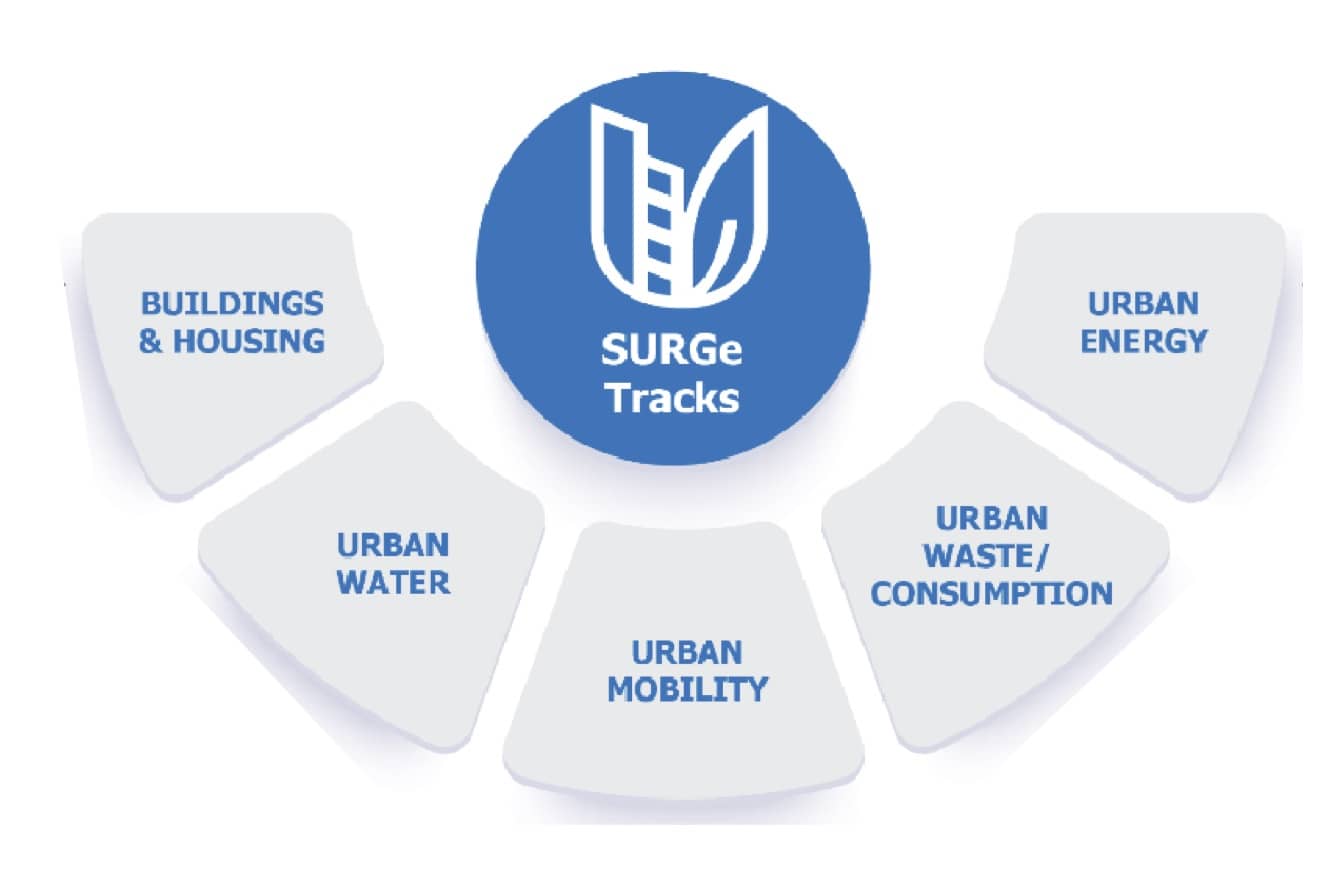
www.buildingsandcities.org/insights/commentaries/launch-surge-cop27.html
The Launch of SURGe at COP27: Breakthrough or Déjà Vu?

By Jeroen van der Heijden (Victoria University of Wellington)
The overall outcomes of COP27 (held in Sharm El-Sheikh, Egypt) have been reported by some as disappointing. However, leading city networks such as C40 and ICLEI claim that subnational governments and cities have made a significant breakthrough with the launch of the Sustainable Urban Resilience for the Next Generation initiative (SURGe). This commentary explores how much of a breakthrough this really is.
What is SURGe?
SURGe is an initiative of the COP27 Presidency in collaboration with UN-Habitat and facilitation of ICLEI. It was launched at the first-ever COP Ministerial for Urbanization and Climate Change. SURGe aims to accelerate local and urban climate action. It seeks to contribute to achieving the Paris Climate Goals and Sustainable Development Goals (SDGs) through multilevel governance, engagement, and delivery through five integrated tracks: building and housing, urban energy, urban waste and consumption, urban mobility, and urban water.
SURGe points out that several vital barriers exist in limiting urban emission reductions, building urban system resilience, and adapting urban systems to climate change. These include a lack of multilevel and cooperative action, a lack of climate finance for cities, and a lack of capacity in cities for developing and planning climate actions. SURGe also points out that feasible measures are available to reduce greenhouse gas (GHG) emissions in cities by 90% by 2050 but that technological and process innovations do not reach all cities because of significant research and action gaps.
SURGe expresses a vision for 2030: "Effective multilevel governance to transform cities to be healthy, sustainable, just, inclusive, low-emission and resilient urban systems for a better urban future for all." It seeks to achieve this vision by strengthening the implementation of the climate agenda in and with cities; unlocking urban climate finance; building capacity in cities; and accelerating technology and innovation in cities. In doing so, SURGe aims to ensure equity, acknowledging that vulnerable groups and communities in cities are often disproportionately and adversely affected by climate change.
What will SURGe do?
To achieve these aims, the Global SURGe Alliance was launched. The Alliance provides an advisory function and will present annual progress at future COPs. This Alliance has already been endorsed by over 120 organizations, including national governments, UN organizations, civil society, academia, the private sector and NGOs, and is open for participation by interested stakeholders.
The day-to-day operation of the initiative will be overseen by a Global Secretariat, co-hosted by UN-Habitat and ICLEI. Together with a steering committee and working groups, it will develop a roadmap and vital success criteria for the initiative. In addition, the Secretariat will seek close collaboration with existing programs, partnerships, initiatives, and campaigns.
Five Working Groups will be launched to develop and disseminate knowledge on the five integrated tracks and to advance and accelerate urban climate actions in energy efficiency, urban water use, and circular (urban) economies.
Breakthrough or déjà vu?
The available SURGe documentation uses all the language we have gotten used to since the launch of Local Agenda 21 in 1992. Cities are portrayed as contributors but mainly as victims of climate change. They are depicted as acting where nation-states have failed. Because a substantial number of cities are committing to climate action and reducing GHG emissions, cities are portrayed as potential saviours of the planet. Whilst this language has great normative appeal, it does not fully reflect reality. Yes, some cities have made significant progress in reducing GHG emissions by taking climate actions. Still, the reality is that many cities around the globe are not on track to reach the goals of the Paris Agreement or different goals set by individual cities for themselves, let alone to reach net-zero emissions by 2050 or sooner.
From the available material, it does not become clear directly whether and how SURGe will deliver on its promise. It is hopeful that SURGe presents a holistic view of the various aspects required to achieve the required urban transition(s) to tackle the climate crisis, including buildings, water, waste, energy, and mobility. This may help overcome the siloed nature of urban climate governance and action that cities often face in daily practice. It is also hopeful to see that SURGe already has the buy-in from national, local and regional governments, urban networks, INGOs (international non-governmental organisations) and NGOs (non-governmental organisations), academia, the private sector and utility companies, and a financial institution. This opens a natural road to multilevel and multi-actor governance. But if SURGe is going to be a breakthrough of COP27, then it needs to move quickly and boldly. So far, it remains a founding document with all the current buzzwords (i.e., 'nature-positive' cities, 'circular' cities, 'health-promoting' cities) and a simple website.
Quick wins could come from changing the habit of undertaking ever more urban climate experiments and pilot projects. Instead, SURGe could promote and help city governments implement existing practices that have a proven track record elsewhere. Quick wins could also come from changing the mindset that 'laggard' cities, citizens, and collectives will voluntarily follow 'climate leaders' and rather acknowledge that many will not make a move unless mandated by law and regulations. Bold actions could include expecting binding commitments from participating cities and other stakeholders and holding those who do not stick to their commitments publicly accountable. Bold actions could also include a shift away from presenting cities as "engines of climate action and [being] at the forefront of delivering solutions" to being open and honest about how few cities actually take meaningful climate action, and how little has been achieved, relatively speaking, since the launch of Agenda 21 in 1992.
Only 7 years until 2030
Over the last three decades, we have witnessed a mushrooming of initiatives, platforms, and networks that aim to accelerate urban climate action. Yet, despite their surge, cities are still not en masse transforming to being healthy, sustainable, just, inclusive, low-emission, and resilient. We do not need another 'feel good' initiative that results in much talk but little action. That would be déjà vu all over again.
It is promising that SURGe had a voice at COP27 and will hopefully have a voice at future COPs. It is also promising that SURGe has true global reach, has a truly holistic view on the role of cities in (addressing) the climate crisis, and is a multilevel and multi-actor initiative. This makes it stand out from existing initiatives, platforms, and networks. But with only seven years until 2030, there is little time left for SURGe to work and achieve a breakthrough. So perhaps a good first question for it to address is: why and how would SURGe succeed where so many other urban climate action initiatives, platforms, and networks have failed?
Latest Peer-Reviewed Journal Content
A living lab approach to co-designing climate adaptation strategies
M K Barati & S Bankaru-Swamy
Mediation roles and ecologies within resilience-focused urban living labs
N Antaki, D Petrescu, M Schalk, E Brandao, D Calciu & V Marin
Negotiating expertise in Nepal’s post-earthquake disaster reconstruction
K Rankin, M Suji, B Pandey, J Baniya, D V Hirslund, B Limbu, N Rawal & S Shneiderman
Designing for pro-environmental behaviour change: the aspiration–reality gap
J Simpson & J Uttley
Lifetimes of demolished buildings in US and European cities
J Berglund-Brown, I Dobie, J Hewitt, C De Wolf & J Ochsendorf
Expanding the framework of urban living labs using grassroots methods
T Ahmed, I Delsante & L Migliavacca
Youth engagement in urban living labs: tools, methods and pedagogies
N Charalambous, C Panayi, C Mady, T Augustinčić & D Berc
Co-creating urban transformation: a stakeholder analysis for Germany’s heat transition
P Heger, C Bieber, M Hendawy & A Shooshtari
Placemaking living lab: creating resilient social and spatial infrastructures
M Dodd, N Madabhushi & R Lees
Church pipe organs: historical tuning records as indoor environmental evidence
B Bingley, A Knight & Y Xing
A framework for 1.5°C-aligned GHG budgets in architecture
G Betti, I Spaar, D Bachmann, A Jerosch-Herold, E Kühner, R Yang, K Avhad & S Sinning
Net zero retrofit of the building stock [editorial]
D Godoy-Shimizu & P Steadman
Co-learning in living labs: nurturing civic agency and resilience
A Belfield
The importance of multi-roles and code-switching in living labs
H Noller & A Tarik
Researchers’ shifting roles in living labs for knowledge co-production
C-C Dobre & G Faldi
Increasing civic resilience in urban living labs: city authorities’ roles
E Alatalo, M Laine & M Kyrönviita
Co-curation as civic practice in community engagement
Z Li, M Sunikka-Blank, R Purohit & F Samuel
Preserving buildings: emission reductions from circular economy strategies in Austria
N Alaux, V Kulmer, J Vogel & A Passer
Urban living labs: relationality between institutions and local circularity
P Palo, M Adelfio, J Lundin & E Brandão
Living labs: epistemic modelling, temporariness and land value
J Clossick, T Khonsari & U Steven
Co-creating interventions to prevent mosquito-borne disease transmission in hospitals
O Sloan Wood, E Lupenza, D M Agnello, J B Knudsen, M Msellem, K L Schiøler & F Saleh
Circularity at the neighbourhood scale: co-creative living lab lessons
J Honsa, A Versele, T Van de Kerckhove & C Piccardo
Positive energy districts and energy communities: how living labs create value
E Malakhatka, O Shafqat, A Sandoff & L Thuvander
Built environment governance and professionalism: the end of laissez-faire (again)
S Foxell
Co-creating justice in housing energy transitions through energy living labs
D Ricci, C Leiwakabessy, S van Wieringen, P de Koning & T Konstantinou
HVAC characterisation of existing Canadian buildings for decarbonisation retrofit identification
J Adebisi & J J McArthur
Simulation and the building performance gap [editorial]
M Donn
Developing criteria for effective building-sector commitments in nationally determined contributions
P Graham, K McFarlane & M Taheri
Join Our Community

The most important part of any journal is our people – readers, authors, reviewers, editorial board members and editors. You are cordially invited to join our community by joining our mailing list. We send out occasional emails about the journal – calls for papers, special issues, events and more.
We will not share your email with third parties. Read more



Latest Commentaries
COP30 Report
Matti Kuittinen (Aalto University) reflects on his experience of attending the 2025 UN Conference of the Parties in Belém, Brazil. The roadmaps and commitments failed to deliver the objectives of the 2025 Paris Agreement. However, 2 countries - Japan and Senegal - announced they are creating roadmaps to decarbonise their buildings. An international group of government ministers put housing on the agenda - specifying the need for reduced carbon and energy use along with affordability, quality and climate resilience.
Building-Related Research: New Context, New Challenges
Raymond J. Cole (University of British Columbia) reflects on the key challenges raised in the 34 commissioned essays for Buildings & Cities 5th anniversary. Not only are key research issues identified, but the consequences of changing contexts for conducting research and tailoring its influence on society are highlighted as key areas of action.